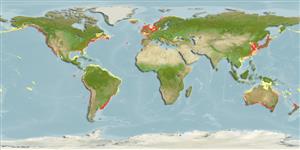Ascidiacea |
Stolidobranchia |
Molgulidae
Environment: milieu / climate zone / Mức độ sâu / distribution range
Sinh thái học
; Thuộc về nước lợ; Mức độ sâu 0 - 90 m (Tài liệu tham khảo 1603). Temperate; 90°N - 41°S, 180°W - 180°E
Indo-Pacific, Atlantic Ocean, Mediterranean, and the Arctic: Europe. tropical to temperate.
Length at first maturity / Bộ gần gũi / Weight / Age
Chín muồi sinh dục: Lm ? range ? - ? cm Max length : 4.0 cm WD con đực/không giới tính; (Tài liệu tham khảo 1749)
Attached to hard substrata or loosely attached on sandy bottoms; from lower shore to depths of about 90 (Ref. 1603). Wharf piles, ships, etc. sea grass, sand or muddy substrates in large aggregates, to 30 m, in salinity 11 to over 20 parts/thousand (Ref. 1134).
Life cycle and mating behavior
Chín muồi sinh dục | Sự tái sinh sản | Đẻ trứng | Eggs | Sự sinh sản | Larvae
Members of the class Ascidiacea are hermaphroditic; both cross- and self-fertilization is typical. Life cycle: Eggs develop into lecithotrophic larva before metamorphosing into benthic adults.
de Kluijver, M.J. and S.S. Ingalsuo 2006 Tunicata: Macrobenthos of the North Sea. Zoological Museum, University of Amsterdam. http://ip30.eti.uva.nl/bis/tunicata.php (Tài liệu tham khảo 1603)
IUCN Red List Status
(Tài liệu tham khảo 130435: Version 2025-1)
CITES status (Tài liệu tham khảo 108899)
Not Evaluated
CMS (Tài liệu tham khảo 116361)
Not Evaluated
Threat to humans
Human uses
| FishSource |
Các công cụ
Thêm thông tin
Sinh thái dinh dưỡngFood items (preys)
Thành phần thức ăn
Thành phần thức ăn
Các động vật ăn mồi
Life cycleSự tái sinh sảnChín muồi sinh dụcSự sinh sảnĐẻ trứngEggsEgg developmentLarvae PhysiologyThành phần ô-xy
Human RelatedStamps, coins, misc.
Các nguồn internet
Estimates based on models
Preferred temperature
(Ref.
115969): 8.4 - 24.3, mean 13.5 (based on 1814 cells).
Fishing Vulnerability
Low vulnerability (10 of 100).
Price category
Unknown.
